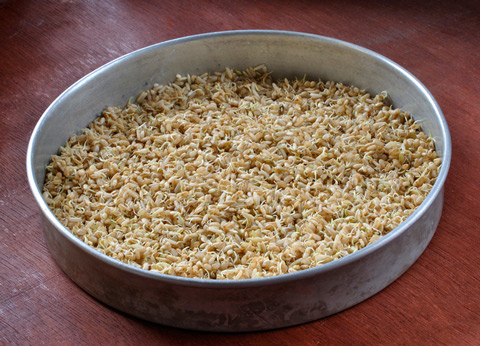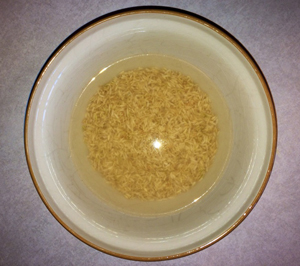
It is widely known that brown rice is healthier than white rice. Although many people favor white rice for its mild flavor and soft texture, it just doesn't quite measure up to brown rice when it comes to nutritional benefits.
Because it retains its nutritious hull, brown rice contains more magnesium, selenium, and especially fiber, which are great for promoting healthy cholesterol levels, good digestion, and lowered blood pressure. In addition, brown rice contains naturally occurring oils that help reduce unhealthy LDL cholesterol found in the blood.
So, with all of that in mind, what if we told you that it is possible to increase the nutritional benefits of brown rice even further? If you haven't already heard of sprouted foods, just wait. They seem to be making quite a splash and will probably continue popping up at grocery and health food stores for some time.
What Is Sprouted or GABA Rice?
GBR (germinated brown rice) or GABA (gabba amino butyric acid) rice is not as complicated as it sounds. When you buy plain rice from the store, you are buying the seeds of a monocot plant, usually Oryza sativa or Oryza glaberrima. Recent studies have shown that if we actually allow those seeds to begin their growing process and then bring that to a halt before eating, their nutritional punch is multiplied significantly.
The Health Benefits: What Is All the Fuss About GBR?
If you think back to when you were a young teenager, you probably ate quite a bit of food and even snacked between meals but never seemed to gain a pound. The reason is that you were using up all of that fuel to help your body grow into something much greater than it was before. All of those vitamins, minerals, proteins, and other nutrients may have seemed to disappear as soon as they entered your mouth, but they were hard at work inside your body before they got used up.
This same concept can be applied to the process of germinating rice before you eat it. Think back to the seeds that are the normal rice that you eat. If we trick those seeds into thinking they are going to grow into a full plant, they will start pumping all of the nutrition they can into themselves, forcing a sprout to emerge. Then, if we put a stop to the growing process when the nutritional levels are the highest and consume the rice then, we can reap all of those amazing benefits for ourselves.
Now that you know why it's called germinated brown rice (GBR), why does it also go by the name of GABA rice? Short for gamma amino butyric acid, GABA is an amino acid that performs as an inhibitory neurotransmitter in the brain. As such, the GABA found in sprouted rice has the potential to support the following: reduced anxiety, lowered blood pressure, improved kidney function, better sleep, increased learning ability, and much more. Some suggest that it could even delay the onset of Alzheimer's, but research is fairly premature in this area.
Purchasing GABA Rice
If you are ready to give GABA rice a chance, you have two options: purchase it or make your own. Although store-bought GABA rice is pricier than standard brown rice, it may be worth it, considering the time and effort it takes to make your own. While regular brown rice is usually only $2-3 for a 1-pound bag, the sprouted version can be 2 to 3 times that price or more. The price will depend on several factors including where you purchase it and whether or not it is certified organic. You may be able to save a couple of dollars by ordering it online or in bulk packages.
In addition to saving time and effort by purchasing sprouted rice, you will also have a supply that doesn't expire for quite a while because the rice has been thoroughly dried and properly packaged for optimal shelf life. On the other hand, your homemade version must be used within 1 to 2 days. If you decide to go the easy way and buy your GABA rice, we suggest Koshikari Premium Sprouted Brown GABA Rice. Ordering online is quick and painless, but if you would rather see your options in person, make a trip to your local Asian market or a health foods store like Whole Foods Market. You'll have the added bonus of asking the staff for brand suggestions and cooking tips.
Making Your Own Sprouted Rice
If you want to try out sprouted rice without having to spend the extra money, you can make your own from regular store-bought brown rice. You can use the cheapest brand available or go for organic. There are several different processes suggested for germinating brown rice but most demand around 24 hours of your time. In addition, it just takes a little bit of your attention and a stable environment.
Although suggested soaking times vary, the Journal of Food Science and technology claims that 3 hours of soaking followed by 21 hours of sprouting is the optimal process for germinating your rice and ensuring the highest levels of GABA (Swati Bhauso Patil, 2011). We tried out the process for ourselves and included step-by-step instructions for creating your own GBR at home.
Do It Yourself: How to Germinate Brown Rice
Items Needed:
- Clean, medium-sized glass bowl
- Whole-grain brown rice (you can also use whole grain red rice)
- Water
- Clean dish towel or cloth
- Fine mesh strainer
Directions:

- Measure out the amount of rice you would like to germinate. We started with 1 cup for use in a single meal. Place in the glass bowl.
- Add double the amount of water (in our case, 2 cups) to your rice and mix together.
- Cover the bowl with a clean cloth, and place it in a warm area in your home. Allow the rice to soak for 3 hours.
- Set the cloth aside, and dump the rice into the mesh strainer. Rinse thoroughly, then shake to remove any excess water. Rinse out the glass bowl, and place the rice back inside. Cover the bowl with the cloth, and place it back in the warm area. Leave the rice alone for 8 hours.
- Repeat step 4.
- Repeat the rinsing process again, then allow the rice to sit for 3 additional hours. The whole process should come to a total of 24 hours.
- Check to see if your rice has changed. It should be slightly puffier, and you may be able to see tiny sprouts appearing near the germ, or the slightly flat, angled end of the rice kernels.
- Rinse and strain the rice a final time, draining as much water as possible, then pat it dry with clean paper towels. Transfer the rice to an airtight container, and store it in the refrigerator until ready to use.
Note: If it is winter, placing the bowl next to a heating vent will work. During summer, opt for a spot that gets direct sunlight. You are aiming to keep the rice at about 86˚F.
Note: Germinated rice that has been prepared this way may only last one to 2 days in the refrigerator. It is highly suggested that you use the completed rice the same or the following day. DO NOT consume the rice if it appears to have gone rancid or has a strong sour or cheesy smell.
Tips and Final Word
Germinating rice at home can be a sort of trial-and-error experiment. Your first batch may not sprout, but don't give up. Even if the sprouts are not fully visible, it probably still contains higher levels of fiber, selenium, lysine, magnesium, and vitamins. As long as your rice is not rancid, try cooking with it to experience the nuttier flavor and softer texture. If you weren't a huge fan of brown rice before, you just may change your mind.
As with any food, leaving it out at room temperature, especially combined with water, can invite unwanted bacteria. If you soak and rinse your rice properly, you shouldn't have any issues with bacterial growth. However, soaking the rice in green tea can help deter this from happening due to the tea's antibacterial properties. Plus, it will infuse the rice with a mellow, herbal, earthy flavor.
When it comes to cooking GABA rice, the process is somewhat simpler. It will take slightly less water and time than cooking regular rice, so adjust accordingly. Both will depend on how much water was absorbed by your rice during the soaking process, which is fairly hard to determine. To make sure your rice turns out perfect for eating, just keep an eye on it while simmering, and add more water if necessary. Do a taste test every few minutes to avoid over-cooking.
GABA rice is still just brown rice. Don't stress over what to do with it. Replace your plain white rice or normal brown rice with GABA rice in any recipe, like Chinese Fried Rice or alongside Thai Stir Fried Vegetables.
Works Cited
- Swati Bhauso Patil, M. K. (2011, Dec.). Germinated brown rice as a value added rice product: A review. Retrieved from Springer Link: DOI: 10.1007/s13197-011-0232-4.
You May Also Like These Articles/Recipes:
Getting Back to Sleep: 14 Tips for Falling Back to Sleep When You Wake up Too Soon
14 Surprising Health Benefits of Sleep
Glucomannan: A Different Source of Fiber


